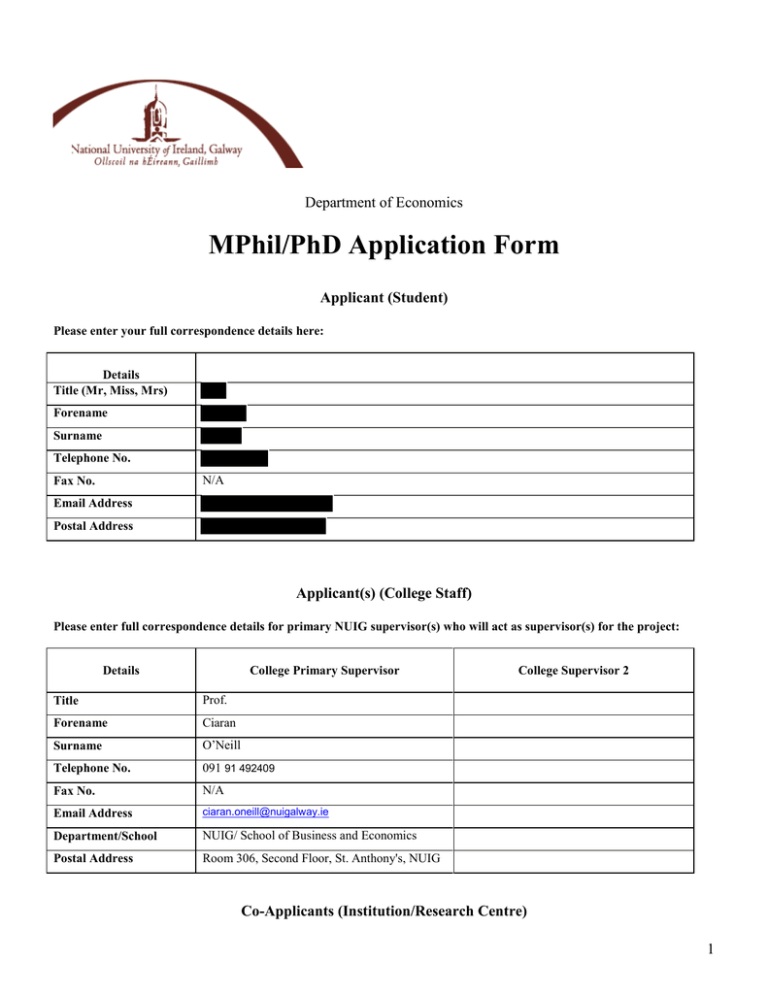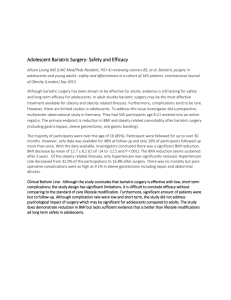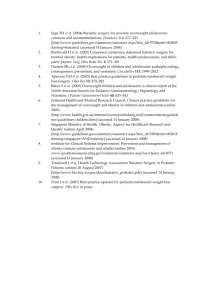MPhil/PhD Application Form Department of Economics Applicant (Student)
advertisement

Department of Economics MPhil/PhD Application Form Applicant (Student) Please enter your full correspondence details here: Details Title (Mr, Miss, Mrs) Forename Surname Telephone No. N/A Fax No. Email Address Postal Address Applicant(s) (College Staff) Please enter full correspondence details for primary NUIG supervisor(s) who will act as supervisor(s) for the project: Details College Primary Supervisor Title Prof. Forename Ciaran Surname O’Neill Telephone No. 091 91 492409 Fax No. N/A Email Address ciaran.oneill@nuigalway.ie Department/School NUIG/ School of Business and Economics Postal Address Room 306, Second Floor, St. Anthony's, NUIG College Supervisor 2 Co-Applicants (Institution/Research Centre) 1 Please enter full correspondence details for Institution Co-supervisors(s) who will act as co-supervisor(s) for the project:* Details Institution Supervisor 1 Title Dr. Forename Francis Surname Finucane Telephone No. 091 542108 Fax No. N/A Email Address Francis.Finucane@mailn.hse.ie Department/School UCHG/ Bariatric Medicine Institution Supervisor 2 Institution Supervisor 3 Centre Postal Address Project Title An examination of the cost effectiveness of Bariatric surgery in Ireland and the value of weight loss Where applicable some institutions such as Teagasc are involved in co-supervision Research Centre Location for Project: UCHG Finish Date: September 2015 Start Date: September 2011 Is the project externally funded: If yes please name the sponsor: Yes No Breakdown of Funding Fellowship Stipend* Other Project funds Total Year 1 €16,000 Year 2 €16,000 Year 3 €16,000 €16,000 €16,000 €16,000 1. PROJECT ABSTRACT (300 words max.) The World Health Orginastion (WHO) has predicted that overweight and obesity may soon replace more traditional public health concerns such as undernutrition and infectious diseases as the most significant cause of poor health. In Ireland a report by the Department of Health and Children (2000) claimed that obesity in adults is increasing by 1% every year. Given the links between obesity, morbidity and healthcare and broader societal costs this presents a significant health and economic challenge to society. The increasing rate of obesity warrants a commensurate response in research and evidenced based policy measures. Currently there is a paucity of research in Ireland regarding the costs of obesity or how it might be best managed in terms of the cost effective use of healthcare resources. More broadly there is a paucity of research as to the value attached weight loss or interventions intended to address weight loss. This is significant given the potential insights such valuations might provide not just of the value of interventions by those who stand to benefit from them but in terms of the probable likely success of interventions aimed at addressing morbid obesity. 2 The research has two principle objectives: to establish the incremental cost effectiveness of Bariatric Surgery among a defined patient group in Ireland and; to examine variations in the value of weight loss among a group Irish citizens that differ in terms of their body mass index and socio-demographic characteristics. With respect to the first objective the methodology will involve an conduct of an evaluation in line with current HIQA guidance for a group of patients referred to UCHG. With respect to the second objective a contingent valuation survey will be conducted on a sample of individuals that includes those who have had surgery, are awaiting surgery and members of the public. 2. PROJECT DESCRIPTION Title: An examination of the cost effectiveness of Bariatric surgery in Ireland and the value of weight loss 2.1 2.2 Objectives: (100 words max.) This project aims to establish the incremental cost effectiveness of Bariatric Surgery within an Irish context. It will also examine valuations attached weight loss among groups differentiated by BMI and whose BMI changes over time. The analysis of cost effectiveness will use standard techniques but importantly within an Irish context examine what if any role is assigned to private medical insurance in cost effectiveness. The examination of WTP will establish values attached interventions and shed light on why treatment success may vary. It is envisaged the value attached to weight loss will be located within the literature on rational addiction. 2.3 Justification (e.g. economic, gaps in existing knowledge, expected benefits) (400 words max.) In Ireland it is estimated that 25% of adults are obese and a further 39% are over weight (Slan: one island, one lifestyle, 2007). Obesity is linked to a number of conditions including type 2 diabetes, hypertension as well as a range of cancers giving rise to significant morbidity, reduced quality of life and health and social care costs (von Lengerke and Kruth, 2011). Evidence in an Irish context moreover indicates a changing pattern of obesity over time not just in terms of prevalence but in terms of the socioeconomic gradient exhibited (Madden, 2010). Within the Irish context; and its complex healthcare system, there is limited knowledge pertaining to the direct and indirect costs of treating obesity or how it might be best managed in terms of the cost effective use of resources. Equally there are various widespread attitudes and beliefs relating to the causes of obesity. While obesity has been linked to sedentary life styles and the ready availability of highly calorific foods, it might be better understood in terms of a model of rationale addiction (Sundmacher, 2011). By gaining a better understanding of the causes and consequences of obesity, as well as the cost effectiveness of treatment options, policy makers will be better able to devise appropriate policy responses. This research will assist in this by examining not only the cost effectiveness of a specific healthcare intervention within an Irish context and by examining heterogeneity across patients with respect to this but by exploring the relationship between individuals of the value attached weight loss. Although the cost effectiveness of Bariatric surgery as a treatment option has been reported in several countries, this has not been done in an Irish context which has a distinct system of healthcare finance and delivery. The study will aid decision makers in making more informed choices in terms of budget resource allocation based on Irish research findings, it will also shed light on why treatment may vary across individuals. Currently there is limited access to bariatric surgery in Ireland. 2.4 Methodology and other details: (Please ensure that sufficient details are provided to enable the reviewers to establish: hypotheses, the relevant/appropriateness of methodologies being proposed.) (1,500 words max.) It is envisaged the research will include a practical research element to investigate questions raised in the study, primarily targeted at Obese and overweight patients in the selected Clinic at University Hospital College Galway (UCHG) and across other weight loss Intervention programs in the West of Ireland. . Research methods may be divided into two elements; 1. Establishing the Incremental Cost Effectiveness Ratio (ICER) 3 In order to establish the ICER and subsequently compare ICER’s, the costs and effectiveness of both surgery and no surgery intervention must be derived. The cost of non-surgery will be established from the cohort that have been referred to UCHG clinic but that have not yet received surgery; (currently a cohort of 92 patients). This will involve identifying all activities associated with Overweight and Obese patients. These activities refer to the health care utilisation of this cohort related to, but not limited to; medication usage, weight management intervention programmes (for example CROI), hospital admissions and ICU admission, The identification of these cost activities will enable costs to be applied to each activity and represented in Net Present Value (NPV). Similarly the cost of surgery of the surgical group will be established; costs would include surgery costs, costs of complications which may require for example band readjustment. Prior to Surgery recommendation that all other routes have been tried and failed; for example weight management programmes and attempted lifestyle modifications. Subsequently there is a wide array of multidisciplinary factors and cost activities associated with surgery apart from surgery itself; which will be examined under the term Bariatric Care as oppose to just Bariatric surgery. In order to measure effectiveness, the QoL for each group will be established. The Health status and health perceptions of each group can be measured, for example obese patients typically have low self-esteem and depression, both of which improve with weight loss; these are measurable with the appropriate QOL tool (Livingston, 2003). The measurement instruments to establish QoL vary from the Medical Outcomes Study 36-Item Short-Form Health Survey (MOS SF-36) which measures 8 domains of QOL to The Nottingham Health Profile scale has also been applied to bariatric surgery studies. However measuring preferences for health outcomes is complex. An alternative approach may be to use pre-scored mulitattribute health classification systems with preference score. For example an EuroQol (EQ-5D) which could be distributed to patients within the clinic. The two steps to the EQ5D process are to identify the health state using a Health Status Classification Questionnaire. Next the researcher would identify utility weight for that health state using a Preference Score table. The EQ5D had five questions or domains; Mobility, Self care, Usual Activities, Pain/Discomfort and Anxiety/Depression, with three levels in each domain; No problem, Some or moderate problem or Unable, or extreme problem. Five domains with three levels give 243 possible health states. Once the Cost and effectiveness of each cohort has been established, an Incremental Cost effectiveness ratio can be derived (∆Costs/∆Effectiveness). A range of sensitivity analyses will be used to ascertain the probability of the intervrention being judged cost effective relative to the current threshold of €45,000 mooted for Ireland as well as thresholds higher and lower than this Subsequent to establishing the ICER for each cohort, both ICER’s can then be compared. Bariatric Surgery would be more cost effective if a) It is less costly and more effective (dominant strategy) b) It is more costly and more effective, but the additional cost associated with Bariatric Surgery is considered worth paying by policy makers c) It is less costly and less effective, but the additional cost associated with the conventional group is not considered worth paying by policy makers. The involvement of healthcare personnel in the study will be important in gaining access to patients for survey work and estimates of resource use. These will also be of assistance in gaining an understanding of alternative treatment pathways, treatments and clinical outcomes. Sample size may prove problematic among those who have received surgery with 91 candidates available only a subset of whom will receive surgery within the timeframe of the study at UHCG. Recruitment of patients will be left open as long as is feasible to facilitate capturer of data on this group. If, however, sample size should remain problematic recruitment through other sites will be considered as will the use of bootstrapped samples. Pilot work conducted as part of a masters dissertation has in many respects demonstrated proof of principle with respect to an analysis of costs for a group of patients deemed suitable for bariatric surgery Any uncertainty in relation to the ICER will be represented through the use of cost effectiveness acceptability curves (CEACs). This has been widely adopted as a method to quantify and graphically represent uncertainty in economic evaluation studies of health-care technologies (Fenwick 2004) 2. Understanding why people are obese The second element of this research aims to gain an understanding of why people are obese with the view that this will aid decision makers in making more informed choices in terms of the most efficient treatment for obesity. Individuals have different time preferences and values associated with BMI and changes in BMI. This can be explored with the utilisation of Contingent Valuation; establish the Willingness To Pay (WTP) in terms of what value people attach to weight loss; how much are they willing to pay to reduce BMI. 4 The researcher will establish samples of obese, overweight and normal weight subjects; and devise survey instruments which will include what the BMI is and also a range of other socioeconomic characteristics. From this, the values that people attach to weight loss will be established; what their QoL is (EQ5D study) with specific reference to overweight & obese groups. A cost benefit analysis (CBA) would be undertaken to establish if the value attached to weight loss is greater than or equal to the cost of Bariatric Surgery. Also if the value attached to weight loss is subject to diminishing marginal utility among a diverse group of over and underweight people; do the values vary across groups based on private insurance and income; to see if values change as weight is lost. Their valuation will be compared with that of a group of individuals who are “normal” BMI >25 and overweight to explore how values compare and what insights can be gained from this within a context of a model of rational addiction. Becker and Murphy (1988) (BM), provide a comprehensive account of addiction that links economics and neurobiology in a ‘rational choice’ framework. The key empirical implication of the BM model is that past and future expected consumptions influence current consumption. It is envisaged that a repeat survey would be necessary; for example when or if BMI changes a second point valuation following the change in BMI would be required. References Prof. Ciaran O’Neill Dr. Francis Finucane 2.5 Workplan and Timescale: (The objective here is to clearly demonstrate that thought has been given the major components of the workplan rather than being overly prescriptive). (Speak to Ciaran) Task Title Timescale Number 1 Text (500 characters) Establish costs of surgery group Number of Months 2 Establish costs of non surgery group Any other relevant information Text (750 characters) 3 4 5 6 7 8 9 2.6 Expected outcomes: (e.g. deliverables) (400 words max.) In addition to a number of peer reviewed journal publications and conference presentations it is envisaged that this study will be of direct policy relevance for the management of morbidly obese patients in Ireland. . The researcher would expect to provide evidence on whether on not Bariatric Surgery is a cost effective treatment of obesity within an Irish context. The researcher would expect to be able to identify and characterise heterogeneity in cost effectiveness among patients. The researcher would expect to provide a better understanding of why certain people are overweight using a model of rational addiction. In relation to the impact that this research would have on policy implications; it would be expected that this research would provide guidelines and a deeper insight relating to what is the most cost effective way to treat obesity in an Irish setting. Combined with 5 this a deeper understanding into the rationale and reasons behind obesity will assist in developing appropriate measures to treat and prevent the escalating disease. 3.1 AFFIRMATION Signature of applicant (student): ____________________________________ Date: ______________________ (Attach list of any relevant publications or reports if applicable for the applicant) 3.2 AFFIRMATION Signature of primary NUIG supervisor (supervisor): ______________________ ____________________________________ Date: (Attach list of 5 most recent peer-reviewed scientific publications for main college applicant) Signature of Institution Co-supervisor: ___________________________________________________________ (Attach list of 5 most recent peer-reviewed scientific publications for Institution Co-supervisor) 6



